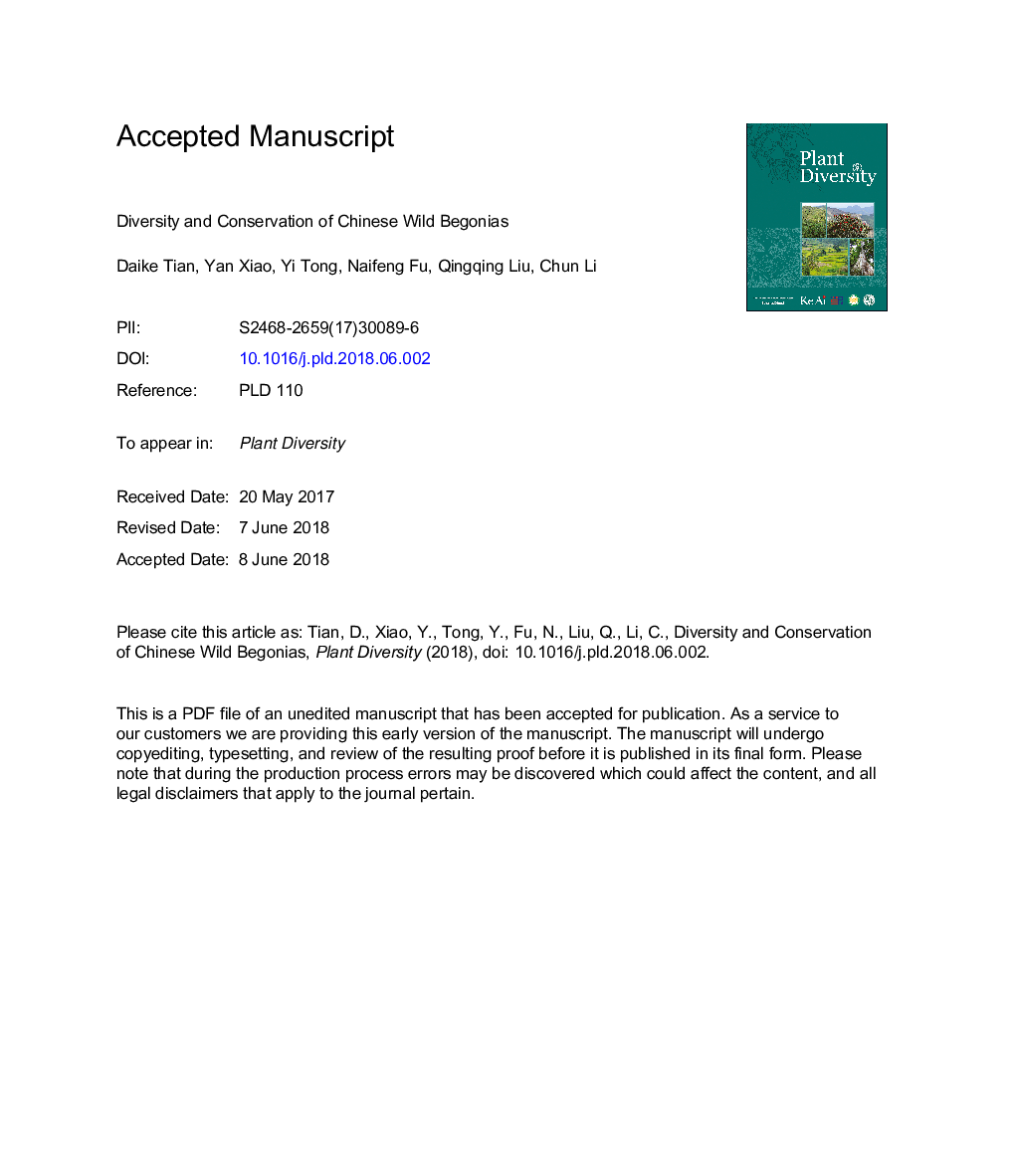| کد مقاله | کد نشریه | سال انتشار | مقاله انگلیسی | نسخه تمام متن |
|---|---|---|---|---|
| 8887568 | 1628244 | 2018 | 41 صفحه PDF | دانلود رایگان |
عنوان انگلیسی مقاله ISI
Diversity and conservation of Chinese wild begonias
ترجمه فارسی عنوان
تنوع و حفظ بگونهای وحشی
دانلود مقاله + سفارش ترجمه
دانلود مقاله ISI انگلیسی
رایگان برای ایرانیان
کلمات کلیدی
بگونیا، ژرم پلاسم، تنوع حفاظت، وضعیت تاکسونومی، چین،
ترجمه چکیده
بگونیا، یکی از گونه های متنوع گیاهان و پنجم یا ششمین جنس بزرگ زردی، شامل بیش از 1800 گونه پذیرفته شده است. تعداد گونه های شناخته شده در این جنس در طول 20 سال گذشته به میزان قابل توجهی افزایش یافته است و از 80 تا 200 گونه تنها در چین افزایش یافته است. بر اساس نظرسنجی های اخیر اخیر، تعداد گونه های بگونیا در چین پیش بینی می شود بین 250 تا 300 باشد. با توجه به تعداد زیادی از گونه های بگونیا که همچنان مورد تعریف قرار می گیرند، کارهای تکاملی بیشتر ضروری است. این به خصوص برای بگونیا چینی است که در آن تنوع زیادی از زیستگاه، عادت، اندازه گیاه، نوع برگ، مورفولوژی گل و میوه وجود دارد، و اکثر گونه ها در زیستگاه های جداگانه که منعکس کننده اختلالات منفی از تغییرات آب و هوایی هستند، و همچنین فعالیت های کشاورزی و صنعتی. با وجودی که وضعیت حفاظت اکثریت گونه ها با استفاده از استانداردهای اتحادیه بین المللی حفاظت از طبیعت مورد ارزیابی قرار گرفته است، نتایج حقیقت را در بسیاری از گونه ها نشان نمی دهد و همچنین حدود 11.5٪ از آنها داده ها نیستند. علاوه بر این، با توجه به رشد سریع تجارت اینترنتی، جمع آوری و جمع آوری غیرقانونی بگونهای وحشی برای استفاده های زینتی و دارویی افزایش یافته است. اغلب پیش بینی می شود، این گونه ها باید به عنوان نادر و در معرض خطر قرار گرفته و به حفاظت فوری نیاز دارند. حفاظت از سواحل بگونهای چینی در سال 1995 آغاز شد و بیش از 60 درصد از کل گونه ها تا کنون توسط چندین باغ بزرگ گیاه شناسی در چین ساخته شده است. با این حال، تنها تعداد کمی از موسسات تحقیقاتی، بودجه محدود و منابع انسانی در حفاظت از بگونیا دخالت دارند؛ افزون بر این، هیچ پروژه ای مجددا وارد نشده است. بنابراین، کار بیشتر بر پایه حفاظت، باید انجام شود. حفاظت بهبود یافته بگونهای چینی در آینده بستگی به بررسی بیشتر زمینه، درک بهتر از تنوع جمعیت و رویکردهای یکپارچه، از جمله حفاظت در محیط و محل زندگی، بانکداری دانه و بازسازی گیاهان است. گونه های حفاظت شده حفاظت شده باید برای گونه های در معرض خطر حذف شده از ذخایر موجود موجود است. علاوه بر این، قوانین مربوط به حفاظت از گیاهان باید به منظور جلوگیری از جمع آوری و انتقال غیر قانونی گیاهان وحشی، به ویژه برای گونه های دارای زیستگاه های منحصر به فرد و جمعیت های کوچک، گسترش یابد.
موضوعات مرتبط
علوم زیستی و بیوفناوری
علوم کشاورزی و بیولوژیک
بوم شناسی، تکامل، رفتار و سامانه شناسی
چکیده انگلیسی
Begonia, one of the most diverse plant taxa and the fifth or sixth largest angiosperm genus, consists of over 1800 accepted species. The number of species recognized within this genus has greatly increased over the past 20 years, rising from 80 to 200 species in China alone. Based on recent field surveys, the number of begonia species in China is predicted to be between 250 and 300. Given the large number of begonia species that still remain to be described, further taxonomical work is urgently required. This is especially true for Chinese Begonia, in which there is a huge diversity of habitat, habit, plant size, leaf type, flower and fruit morphology, and most species are narrowly distributed in isolated habitats that are subject to negative disturbances from climate change, as well as agricultural and industrial activities. Although the conservation status for the majority of species has been evaluated using the standards of the International Union for Conservation of Nature, the results don't represent the truth in many species, and also about 11.5% of which are data-absent. In addition, illegal collection and over-harvesting of wild begonias for ornamental or medicinal use has increased due to the rapid development of internet commerce. Far more often than predicted, these species should be categorized as rare and endangered and require immediate protection. Ex situ conservation of Chinese begonias started in 1995 and over 60% of the total species have been so far introduced into cultivation by several major botanical gardens in China. However, only few research institutions, limited funds and human resources have been involved in Begonia conservation; moreover, no project has conducted reintroduction. Therefore, more conservation-based work remains to be done. Improved conservation of Chinese begonias in the future depends on further field survey, an improved understanding of population diversity, and integrative approaches, including in situ and ex situ conservation, seed banking, and plant reintroduction. Species-targeted conservation zones should be established for endangered species excluded from the existing nature reserves. Additionally, laws pertaining to plant protection should be extended to prevent the illegal collection and transaction of wild plants, particularly for those species with unique habitats and small populations.
ناشر
Database: Elsevier - ScienceDirect (ساینس دایرکت)
Journal: Plant Diversity - Volume 40, Issue 3, June 2018, Pages 75-90
Journal: Plant Diversity - Volume 40, Issue 3, June 2018, Pages 75-90
نویسندگان
Daike Tian, Yan Xiao, Yi Tong, Naifeng Fu, Qingqing Liu, Chun Li,
